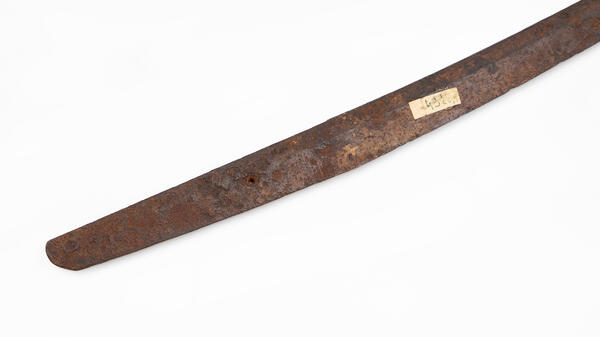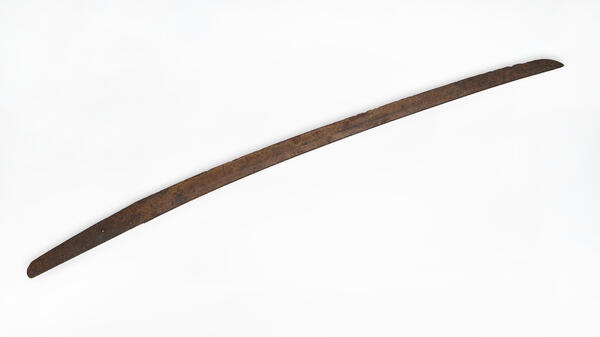The Japanese short sword shōtō, or wakizashi, from the museum’s collection was forged in Japan at the beginning of the 16th century (Muromachi period). These swords were mostly used by samurai. They were worn paired with a katana, on a belt.
Often, wakizashi and katana were made by the same master, and the swords had the same style. This pair of swords was called “daishō”, which meant “long — short” or “big — small”. In the pair, daishō wakizashi was used as a short sword (shōtō). Samurai used wakizashi as a weapon when the katana was unavailable or inapplicable. Such a sword was always carried with them and was called the “keeper of honor.”
The blade presented in the exhibition has a traditional design with a ridge, known as the shinogi-zukuri. The ridge gave the sword extra rigidity. Such a sword is characterized by a bend called “koshizori” with maximum curvature near the tang where the sword touched the human body when worn.
The butt of the blade — the back — was made by the master in the style of a traditional ridge of the roof of the house; he gave the tang of the nakago an original for the area and the school form of a tip called “ha-hagari-kuri-jiri”.
On the tang on both sides there is a hieroglyphic inscription, the signature of the master who made the blade. This is the traditional location of the signature. There are six hieroglyphs on the omote, that is, on the outer front side of the tang. An inscription of seven hieroglyphs has been preserved on the back of the tang.
The Bishū hieroglyphs are the traditional shortened name of the province where the blade was made. Bishū, or Bizen, is a historical province of Japan, located in the west of Honshu Island. It was known for its blacksmiths, who forged some of the best swords in Japan.
The next two hieroglyphs, Osafune, are the name of a village in Bizen province, where blacksmiths and their families lived. It was one of the important centers of weapons production in Japan during the Nanbokuchō and Muromachi periods, and the term “Osafune school” even appeared in history. The last two characters, Sukemitsu, are the name of the master who made the blade. Such names were dynastic and were inherited from father to son.
The hieroglyphs on the
back are a date in the traditional Japanese nengō calendar, in which the years
are counted according to the eras of the reign of the emperors. These
hieroglyphs indicated to the researchers the time of the blade’s manufacture.
The sword presented in the exhibition is dated to the eighth month of the third
year of the Eishō era, which, translated into the generally accepted
chronology, means August 1506.




